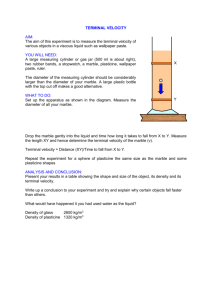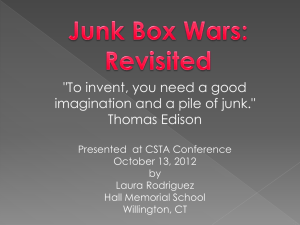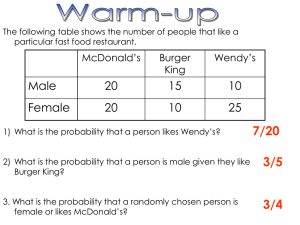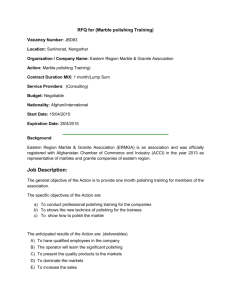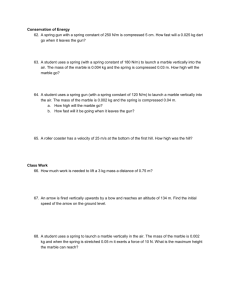Supplementary--REVISED--L13-08585
advertisement
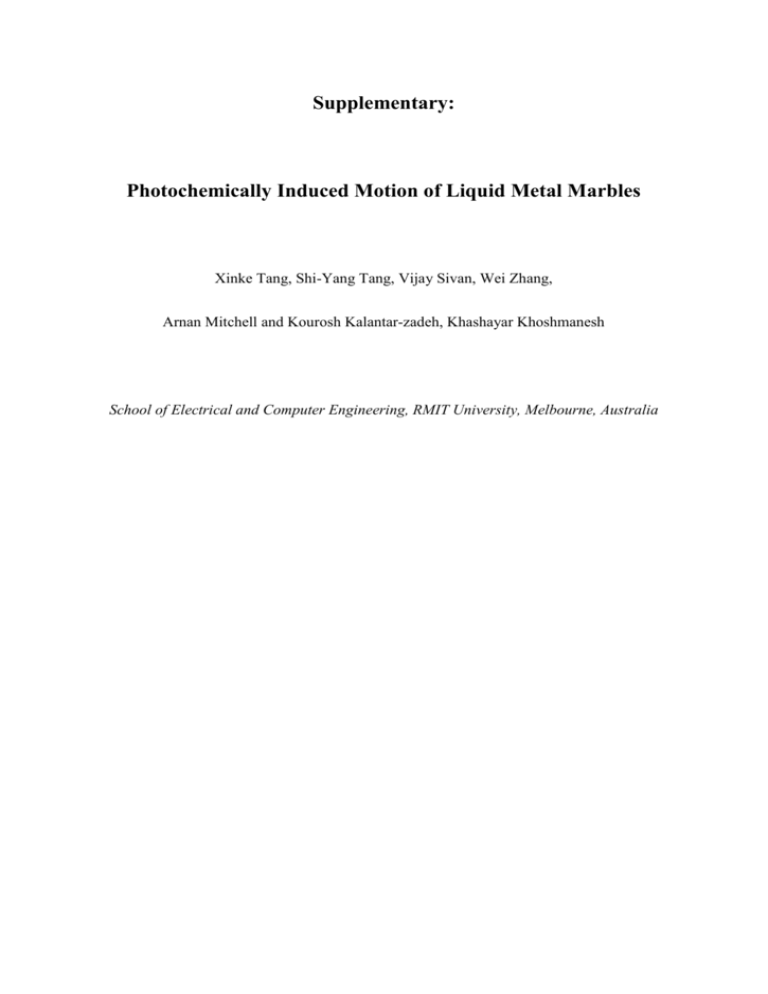
Supplementary: Photochemically Induced Motion of Liquid Metal Marbles Xinke Tang, Shi-Yang Tang, Vijay Sivan, Wei Zhang, Arnan Mitchell and Kourosh Kalantar-zadeh, Khashayar Khoshmanesh School of Electrical and Computer Engineering, RMIT University, Melbourne, Australia Supplementary 1: Experimental setup FIG. S.1. (a) Photo of the experimental setup. Liquid metal marbles are prepared by rolling a droplet of liquid metal galinstan (Geratherm Medical AG, Geschwenda, Germany) on a WO3 nano-particle powder bed until the surface of galinstan droplet is entirely covered by the particles. Aqueous solutions of hydrogen peroxide (30% v/v, LabServe) with different concentrations are freshly prepared by using deionized (DI) water as the solvent before the experiments. The WO3 coated galinstan marble is placed in a 35 mm petri dish (LabServe) filled with 4 ml of H2O2 solution, and placed on the stage of an inverted microscope (Eclipse Ti, Nikon). The stage was tethered to a linear screw actuator with a velocity in the order of 0.1 to 50 mm/min which pulled the microscope stage at the desired speeds. (b) The actuation path of the marble within the petri dish is defined by two stripes with a thickness of 1 mm attached on both sides of the marble. UV radiation from a ultrahigh pressure 130 W mercury lamp (Intensilight C-HGFI, Nikon) is focused onto the marble through a UV filter (MBE41300 C-FL Epi-Fl Filter Cube DAPI, Nikon) using a 10× objective lens. Different light intensities are accurately regulated through a neutral density filter installed in the illuminator (Intensilight C-HGFI, Nikon). Supplementary 2: Analytical model for prediction of marble’s speed assuming compressible gas within the bubbles Basic equations as described in the main text: (S.1) U marble r bubble cos mbubble bubble 4 3 rbubble 3 (S.2) (S.3) The rate of bubble generation can be calculated as: 4 3 2 mbubble bubble 3 rbubble bubble 4 r bubble rbubble Assuming bubbles behave like an ideal gas: bubble P RT (S.4) in which P is the pressure of the bubble, R is the universal gas constant and T is the temperature. When the bubble is generated under the marble, it experiences the weight of the marble, and therefore its pressure is obtained as: P (S.5) M marble g Patm 2 rbubble Combining equations (S.4) and (S.5) leads to the following equation: M g r bubble bubble P marble 3 RT RT rbubble (S.6) Substituting equations (S.6) in (S.3) leads to the following equation: M g r bubble 4 3 M marble g 2 mbubble 2 marble r 4 r bubble bubble rbubble 3 2 RT 3 rbubble R T rbubble M g 8 M marble g r bubble 4 marble r bubble 3 RT RT (S.7) 4 M marble g r bubble 3 RT Assuming the marble droplet has a spherical geometry: 4 3 M marble marble Rmarble 3 16 marble g 3 mbubble Rmarble r bubble 9 RT (S.8) On the other hand, the rate of bubble generation can be expressed as: 2 mbubble I CH 2O2 Rmarble (S.9) Combining equations (S.8) and (S.9) leads to the following equation: r marble 9 RT 16 marble g I CH 2 O2 Rmarble I CH 2 O2 (S.10) Rmarble Combining equations (S.1) and (S.10) results in: U marble r bubble cos U marble I C H 2O2 Rmarble (S.11) Supplementary 3: Calculated data U marble I CH 2 O2 Rmarble U marble I U marble k1 I where k1 is a constant Predicted speed (mm/min) α=1 α=0.5 I 12% 1.32 1.73 25% 2.75 2.5 50% 5.5 3.53 100% 11 5 U marble CH 2O2 U marble k2 CH 2O2 where k2 is a constant Predicted speed (mm/min) U marble 1 Rmarble U marble CH2O2 β=1 β=0.5 3% 1.77 2.07 7.50% 4.425 3.286 15% 8.85 4.64 30% 17.7 6.57 k3 R where k3 is a constant 1 Predicted speed (mm/min) 9 2 4.5 3 3 R (mm)


